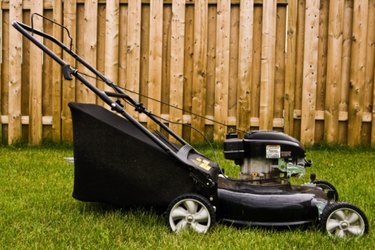Things You'll Need
Primary governor spring (if required)
Electronic tachometer
Set of wrenches
Nut driver
Tang bending tool

The lawnmower governor is designed to maintain the engine speed set by the throttle lever, regardless of the load imposed. When the engine slows down while cutting through thick grass, the governor opens the throttle automatically, thus maintaining the preset engine speed. Conversely, when the mower clears the load, the governor compensates by closing the throttle sufficiently to prevent the engine from racing. There are two types of governors: pneumatic governors controlled by a pivoting vane near the flywheel, and centrifugal governors geared to the crankshaft. Governors require periodic adjustment, but this is a fairly straightforward process.
Inspection
Step 1
Disconnect the spark plug lead and secure it away from the spark plug.
Video of the Day
Step 2
Pull gently on the throttle lever on top the carburetor to ensure that the attached governor linkage moves freely and stretches the governor spring.
Step 3
Inspect the governor spring if vibration has caused it to slip off the linkage. If the spring has stretched, replace it. If not, reconnect it to the governor linkage.
Mechanical Governor Adjustment
Step 1
Loosen the clamp bolt holding the governor lever to the shaft protruding from the engine with a small wrench. Move the governor lever back and forth to ensure that it moves freely on the shaft.
Step 2
Move the throttle lever back until it rests against the idle speed adjusting screw. Take careful note of the direction of rotation on the governor arm.
Step 3
Place a nut driver over the governor shaft protruding from the engine. Turn the shaft in the same direction that the governor arm rotated, until it won't go any further.
Step 4
Tighten the clamp bolt holding the governor lever to the shaft protruding from the engine. Move the governor linkage back and forth to ensure that it moves freely.
Top No-Load Speed – Single Spring Governors
Video of the Day
Step 1
Consult your authorized dealer for the recommended maximum no-load speed on your mower; this varies, depending on the engine model. If your engine has two governor springs, skip to the "Top No-Load Speed – Dual Spring Governors" section.
Step 2
Re-attach the spark plug lead to the spark plug. Wrap the red lead from an electronic tachometer around the spark plug lead and attach the ground wire alligator clip to one of the cylinder head bolts.
Step 3
Move the mower onto a hard, smooth surface. Start the engine and allow it to run for five minutes at idle speed to reach normal operating temperature.
Step 4
Open the throttle fully and monitor the engine's rpm on the tachometer. If the engine races over the recommended no-load speed, or runs at a reduced rpm, go to Step 5.
Step 5
Loosen the clamp bolt holding the governor lever to the shaft protruding from the engine with a small wrench if you have a mechanical governor. Move the governor lever until the tachometer shows the recommended maximum no-load speed, and tighten the clamp bolt to maintain the new setting. If your engine has a pneumatic governor, go to Step 6.
Step 6
Place the forked ends of a tang bending tool over the tang between the governor spring and the throttle plate, if your engine has a pneumatic governor. Bend the tang either way to stretch or shorten the governor spring until the recommended maximum no-load speed is reached.
Top No-Load Speed – Dual Spring Governors
Step 1
Consult your authorized dealer for the maximum no-load speed on your mower; this varies, depending on the engine model.
Step 2
Re-attach the spark plug lead to the spark plug. Wrap the red lead from an electronic tachometer around the spark plug lead and attach the ground wire alligator clip to one of the cylinder head bolts.
Step 3
Move the mower onto a hard, smooth surface. Start the engine and allow it to run for five minutes at idling speed to reach normal operating temperature.
Step 4
Place the forked ends of a tang bending tool over the secondary governor spring tang. Bend the tang until the spring collapses fully without exerting any tension.
Step 5
Place the forked ends of a tang bending tool over the larger primary governor spring tang while the engine is idling. Bend the tang until the tachometer shows a speed 200 rpm below the recommended maximum no-load speed.
Step 6
Bend the secondary governor spring tang until there is some tension on the spring, and the idle speed increases slightly. Carefully bend the tang the other way until the idle speed reaches 200 rpm below the recommended maximum no-load speed.
Step 7
Open the throttle fully and monitor the engine speed. Bend the primary governor spring tang until the engine speed matches the recommended maximum no-load speed.
Tip
Although the above procedures are for Briggs and Stratton engines, most other lawnmower engine governors, such as Tecumseh, are adjusted in an almost identical fashion.